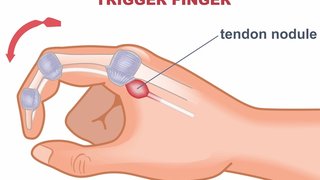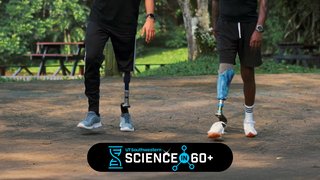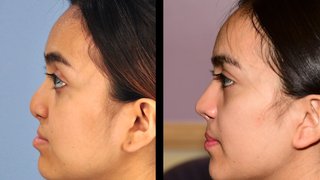Improving smiles with a new surgical technique to treat facial synkinesis
May 15, 2024

Facial paralysis can occur for many reasons, all of which have one thing in common: injury to the facial nerve. Causes for facial nerve injury can range from Bell’s palsy, skull base trauma, tumors, and infections such as in Ramsay Hunt syndrome, which is caused by a viral infection. (In 2022, singer Justin Bieber canceled his concert tour to deal with the effects of Ramsay Hunt.)
After facial paralysis, a patient can typically expect one of three outcomes:
- Normal function returns after a short period of time.
- Long-lasting or permanent facial weakness sets in.
- Postparalysis facial synkinesis (PPFS) emerges, causing a spectrum of symptoms including tightness around the eye, unwanted movements, such as twitching, closure of the eye when attempting to smile or during eating, and constant contracted muscles in the face and neck often affecting the upper or lower lip.
Synkinesis is perhaps the least discussed – yet likely most common – negative outcome of facial paralysis, regardless of the cause. Depending on the severity, it has significant impact on facial function, facial appearance, and quality of life.
We don’t exactly know why synkinesis develops, but most theories involve abnormal nerve regeneration. To visualize the brain’s message disruption, picture a six-lane highway. Each lane is assigned to one color car: red, yellow, or blue. Then there’s a crash – the inciting incident of paralysis. The cars become jumbled across the lanes. Over time, the debris is cleared away and the highway starts moving again, but not like it used to. Blue cars are in the yellow lane, red cars in the blue lane, and while it’s functional, it doesn’t look or function the same as before the accident.
Microsurgeons in the UT Southwestern Department of Plastic Surgery, led by Dr. Shai Rozen, recently developed a cutting-edge procedure to rebalance the smile following PPFS by focusing on the mentalis muscle, which runs from the lower chin to the lower lip, and the surrounding nerves which innervate it. Our research in surgical synkinesis treatment won the Joint Outstanding Podium Presentation and Best Paper Award 2024 at the American Society of Reconstructive Microsurgery Annual Meeting.
What does facial synkinesis look like?
There are two major categories of facial palsy:
- Flaccid facial palsy causes a “floppy” face with no movement. It may be accompanied by a drooping eyebrow or eyelid and inability to close the eye. Other symptoms include sagging at the corner of the mouth, which can make it difficult to eat and smile.
- Post-paralysis synkinesis is characterized by excessive tone or tension of the facial muscles and uncoordinated movements and muscle contraction. In synkinesis, for example, when your brain tells your facial muscles to smile, the muscles may oppose one another rather than work together, causing dysfunction, involuntary movements, and often exaggerated baseline contraction of the facial muscles.

Although some patients’ faces remain paralyzed, some return to normal function over three months. Most commonly, if one does not regain normal function within three months, but develops some motion, then varying levels of synkinesis will ensue, potentially causing an uneven smile and scrunching eyes. These symptoms can get worse over time due to disruption of signals from the brain to the face and misaligned pathways resulting in uneven muscle tone.
Other symptoms may include:
- Uncontrolled muscle contracture around the eye, cheek, and chin
- Tightness around the eye and in the face and neck, causing discomfort
- Lip and cheek lifting when the eyes are closed
- Watering eyes when eating
- A deeper cheek crease on the affected side of the face
Related reading: How Susan got her smile back
How is facial synkinesis diagnosed and treated?
Synkinesis is characterized by three main components.
- Constant and uncontrolled contracture of facial muscles: Also referred to as baseline hypertonicity of the facial muscle. Imagine you are in the sunshine without sunglasses and constantly squinting. You can’t see and after a while you might feel discomfort due to prolonged contraction of the muscles around the eyes. In patients with synkinesis, the eye is constantly squinting, the midface is tight and full, and patients notice biting the cheek or lip because the muscles of the inner cheek or chin are tight.
- Mouth moves when eyes squint or shut. This form of co-contracture is called oral-ocular synkinesis and ocular-oral synkinesis. When a person with synkinesis tries to smile or purse his or her lips, the eyes frequently squint or even close and sometimes the brow moves. During eye closure, the mouth may move. Patients often notice that the synkinetic eye squints or shuts when chewing.
- Corner of the lip pulls down while trying to smile: This is caused by co-activation of agonist and antagonist muscles – pathologic co-contraction. Envision you curl a barbell by contracting your biceps but the weight won’t move since the triceps muscle is contracting at the same time, performing the same action in the opposite direction.
Patients with synkinesis suffer functional problems from these variables – they can’t smile, they have facial distortion, and some have facial discomfort. Smiling is extremely important. It is how we communicate joy, empathy, love. Facial asymmetry and contracture will often convey a feeling of anger when the person is happy.

The main goal of treatment in synkinesis is to rebalance the face and provide improved control over facial movement, especially the smile and oral function. The surgical approach to synkinesis includes selective myectomies (releasing certain dysfunctional muscles) and selective neurectomies (removing certain dysfunctional facial nerve branches).
In less severe cases, surgery to release the depressor anguli oris (DAO) muscle, which runs from the jawbone to the corner of the mouth, can relieve some of these symptoms.
While highly effective for some patients, DAO myectomy does not always fully correct asymmetry of the smile. Despite some improvements, the lower lip will frequently remain high, covering the upper teeth and resulting in continuous asymmetry and biting of the lips. In these patients, selective neurectomies can be added. Even then, some patients continued to have lower lip elevation, which frequently was considered to be a result from weakness of a muscle that depresses the middle lower lip, the depressor labii inferioris (DLI) muscle.
The only way to improve care for patients is to constantly examine and critique previous results; question conventional approaches and be willing to adjust and keep an open mind, according to Dr. Rozen, lead author of the study.
After better understanding the effect of the mentalis muscle and its innervation patterns, we recognized that in synkinetic patients it was overpowering the DLI muscle (which naturally pulls the lip down) by pushing the lip upwards. The DLI wasn’t paralyzed. This initial observation, followed by further anatomical and physiological studies at UTSW, gave us an opportunity to improve upon DAO surgery by offering selective mentalis neurectomies, which ultimately provided better patient outcomes”.
What's coming in the future for patients with synkinesis?
While there is currently no defined time for intervention in patients with established synkinesis, we typically recommend surgery only after a year past the onset of the initial event of paralysis. While waiting can be frustrating for patients, damaged nerves may continue to regenerate abnormally, and it is better to see the fuller picture of where a patient is at one year compared to a partial picture at six to nine months.
Premature surgery could miss or fail to address some problems that may only appear later in the recovery process.
If you have symptoms of facial synkinesis, visit with a specialist who regularly treats facial paralysis. An experienced facial paralysis surgeon will want to get to know you and establish a relationship, because they will want to closely monitor you and observe the evolution of the paralysis. You want to choose a surgeon who will know when, if, and what kind of surgery is the best option for your synkinesis.
At UT Southwestern, we passionately continue to refine our procedures and develop new ones. Our goal is not only to restore function and appearance, but to make our patients happy so they can continue enjoying life after facial paralysis.
To talk with a specialist, call 214-645-2353 or request an appointment online.











